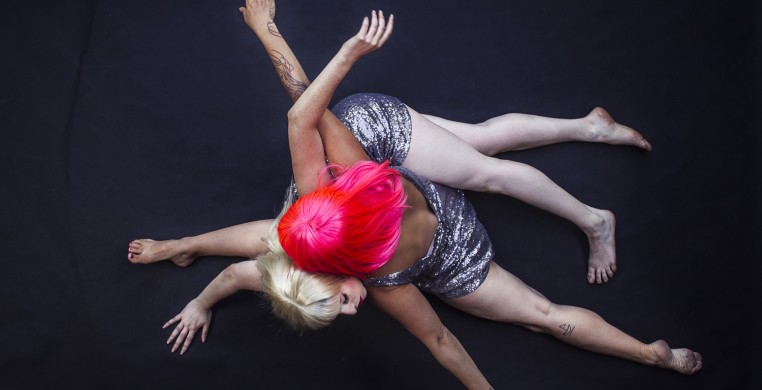On the heels of a successful month in “The Cronus Land,” Jonathan Meyer and Julia Rae Antonick brought Khecari back to the basics for a double bill with Blind Tiger Society Dec. 19 as participants in Links Hall’s Midwest Nexus Project. Midwest Nexus brings two new companies together for cross-country engagements in each one’s home city. The program is designed to provide a catalyst for experienced out-of-town groups to tour to Chicago, supported by an apprentice producer. Dubbed “Ring Sour,” Khecari’s collaboration with San Francisco-based Blind Tiger Society travels to the west coast in spring, 2016, produced by Columbia College Chicago student Jasmine Mendoza (mentored by Rachel Damon).
Prior to the evening's main event, Meyer and Antonick treated us to a three-hour durational performance of a duet begun in 2014, Orders from the Horse. The improvised Orders from the Horse explores the space between asleep and awake, and I walked in at about 6:20 pm to find Meyer standing in the corner, swaying, with his eyes rolled back in his head, while Antonick huddled in a small burlap fort. It’s not clear whether Meyer and Antonick are aware of each other’s presence – they certainly don’t seem aware of ours.
During the durational performance, the program gives us permission to come in and out of the performance physically (you can get up and go eat, go to the bathroom, and come back whenever), and mentally. Like staring at a painting, the viewer gets to chose his level of involvement and how he looks at the thing. Chairs are placed in an amoeba formation, but per usual with Khecari, nothing about the space seems willy-nilly. Each of us is given a hand-drawn map describing the locations of performance spaces for the two dancers (Meyer and Antonick), long-time Khecari composer Joe St. Charles, and lighting designer Kat Sirico, who, with stage manager Randi Wallace, manipulated stage lights, two burlap drops hung in S-curves, and a tangle of Edison bulbs hanging downstage, live.
The bulbs cast a pulsating amber glow across the ordinarily sterile white space, like a nightlight or a mess of ideas (particularly evident when Antonick and Meyer stood beneath their chandelier). Although Sirico’s lighting was beautiful, it changed too frequently to fully appreciate the effects of each look. I sometimes found this to be the case for the main event’s dancing too, an additional half hour of Antonick and Meyer improvising, but at an accelerated pace. Had I not seen any of the durational performance, it might not have occurred to me that the main event felt impatient; the excitement of an amped up version of the same theme is not lost on me – particularly knowing the two had already been dancing for three hours prior. It’s worth mentioning, however, that the “come and go as you please” attitude faded away and we were treated to a more presentational, “dancier” flow – as if the two knew that more people were watching, and wanted to give them their money’s worth.
Despite all the details, this was a stripped-down performance compared to Khecari’s recent endeavors into built spaces for their work, making for an easy transition to the show's second half. Blind Tiger Society’s Dressage opted for Links’ blank white walls as its backdrop. Bianca Cabrera and Rebecca Morris emerge in lamé jumpsuits and glittery lipstick, lip syncing arm in arm. In stark comparison to the always-serious Khecari, Blind Tiger’s Dressage attacks serious issues through humor and metaphor. In keeping with the evening’s horse theme (ish), dressage, a presentational equestrian event, is all about how a horse looks and behaves. Cabrera and Morris compete for the audience’s attention, stepping over, under, and on top of one another, and using their glittery lips and overtly sexual dance moves, as though putting themselves on display.
A world premiere, Dressage was too long and failed to fully exploit a fantastic pair of belts with tangled boa bustles attached. At times, intricate passes of partnering were clunky, at best, particularly when compared to the super smooth Jonathan Meyer and Julia Rae Antonick. However, Cabrera and Morris show some serious dance chops in other sections, and it occurred to me that some of the acrobatics might have been intentionally strained. Dressage creates powerful imagery – it’s a thing that made me go hmm – but will perhaps benefit from a bit of editing and marinade before Ring Sour’s SF showing.
Note: to be considered for press coverage on SeeChicagoDance.com, submit press materials to editor@seechicagodance.com and post your event here

